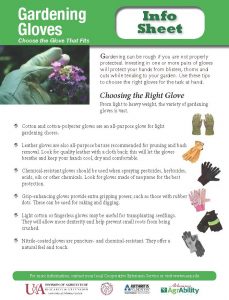
Fruits
New Strawberry Disease in Ohio?
A new strawberry disease has been found in Indiana and researchers are looking for samples to determine the extent of the problem. The disease, caused by a species of the fungus Neopestaltiopsis, has been reported in several southeastern states and other countries where it causes leafspots, fruit spots and a plant decline. In Indiana, the disease has been reported to cause a leafspot (Figure 1) and a plant decline. This disease resembles Phomopsis and upon further investigation may ultimately turn out to be Phomopsis.
Specialty Crop Webinar
What’s your GDD?
Amy Stone, Extension Educator- Originally posted on the Buckeye Yard and Garden onLine
Has anyone every asked you, “what’s your GDD?” While many of you may have responded “yes,” or may have even thought, “I ask others all the time“; I know there are some that probably yelled out their current GDD when simply reading the title of this alert. If you are still wondering what the heck is GDD – keep on reading, you won’t be disappointed and will hopefully click on the link below to find out your GDD to date.
Knox County Master Gardener Volunteers WANTED
Share your love of gardening while giving back to the community!
Learn: Master Gardener trainees receive University level training in horticulture from The Ohio State University Extension in the areas of botany, soils, trees, flowers, lawns, fruits and vegetables, entomology, pest management, and diagnostic skills. Trainees complete a minimum of 40 hours of training.
Give: After training, new volunteers will work with each other in various activities in Knox County to complete 50 hours of service in the first year. Opportunities include: answering horticultural questions, educating local gardeners on plant selection and care, helping community members within the community gardens and more. There are numerous ways to be involved in the community and you can be a part of it!
Grow: Master Gardeners enjoy the social aspect of learning together, volunteering together, and helping other in out county.
Join: If you are interested in gardening, want to help your community grow, and want to learn more, the Ohio State University Master Gardener is for you!
For more information or to obtain an application contact Sabrina Schirtzinger at 740-397-0401 or schirtzinger.55@osu.edu. 

Gardening Gloves: Finding the Right Fit
Spring is right around the corner. What is the condition of your garden gloves? How many pairs do you own? Different gloves may be best for certain situations. Some wear out faster than others. Here is a informational sheet about choosing the right garden glove for your hands. There is even a section on how to clean your gardening gloves! How many of you actually do this step!?
Home Apple Tree Disease Management
Are you trying to grow apples in your backyard? Do you struggle with apple fruit rots and other diseases? Educator Sabrina Schirtzinger is always available to help you create a management plan, assist with identifying your fruit tree issues, recommend sprays to suppress disease and more. Before the season begins brush up on problems you saw last year with OSU’s new publication “Disease Management in Home Apple Plantings”.
Alion labeled for blueberry, caneberry and hops
Blueberries
Use on blueberry has been established at least one year. Bushes must be vigorous and exhibiting normal growth. Avoid application to areas where roots are exposed or low areas where the herbicide could move into the blueberry root zone. Do not use Alion on soils classed as sand or soils with more than 20 percent gravel.
For soils with less than 1 percent organic matter, the application rate is 3.5 fluid ounces (0.045 pounds active ingredient) per acre, with a maximum of 7 fluid ounces per year in two applications. On soils with more than 1 percent organic matter, the application rate is 5 fluid ounces (0.065 pounds active ingredient) per acre, with a maximum of 10 fluid ounces per year in two applications.
Apply Alion when the plants are dormant, from late fall through early spring before bud swell. Alion should be applied to the soil on both sides of the row.
Caneberries
Use on caneberry has been established at least one year. Do not apply to soil classed as sand or on soils containing more than 20 percent gravel. On soils with less than 1 percent organic matter, use up to 3.5 fluid ounces of Alion and a maximum of 7 fluid ounces in two applications per acre per year. On soils with more than 1 percent organic matter, apply up to 5 fluid ounces with a maximum of 10 fluid ounces in two applications per year.
Apply when plants are dormant in late fall or early spring before bud swell. Apply to soil at base of canes.
Hops
Use on hops has been established at least one year, and that are growing normally with good vigor. Do not apply Alion to soils classed as sand or contain more than 20 percent gravel. On soils with less than 1 percent organic matter, use 3.5 fluid ounces per acre with a maximum of 7 fluid ounces per acre per year. On soils with more than 1 percent organic matter, use up to 5 fluid ounces with a maximum of 10 fluid ounces per acre per year.
Apply in early spring or fall after vine harvest. In spring, Alion may be applied on hops in the bud stage with shoots up to 2 inches in length. Apply in a 2-foot band on each side of the row.
Download the label at CDMS.









